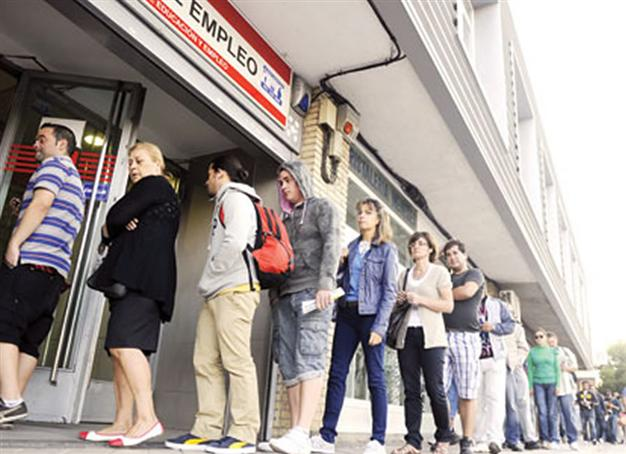Standard & Poor’s cuts Spanish credit rating
MADRID - Reuters

People wait at a government employment office in Santa Eugenia’s Madrid suburb on Oct. 4. The number of unemployed in Spain increased in September to 4.226 million. AFP photo
Standard & Poor’s cut Spain’s credit rating on Friday, sending the euro lower and underlining the challenges facing Europe’s big powers as they met their Group of 20 counterparts over the eurozone debt crisis.S&P, whose move mirrored that by fellow ratings agency Fitch last week, cited high unemployment, tightening credit and high private-sector debt among reasons for cutting the nation’s long-term rating to AA- from AA.
“S&P underestimates the scope of the unprecedented structural reforms undertaken, which will obviously take time to bear fruit,” Spain’s Treasury said in a statement for investors on Friday.
Spanish unemployment, running at 21 percent, is the highest in the European Union, reflecting a stagnant economy, the collapse of a decade-long housing boom and cuts aimed at reeling in a public sector deficit which reached 11.1 percent of gross domestic product (GDP) in 2009.
High yields on Spanish government bonds point to concerns that it could be the next euro zone economy to require a Greece-style bailout and despite an unpopular austerity programme, doubts remain that Spain will meet its deficit target of 6 percent of GDP this year.
No way to privatize
Furthermore, the decision to shelve Spain’s multi-billion-euro privatization plans, mainly due to tough market conditions, has deprived the state of much needed revenues to cut borrowings and leaves little room for manoeuvre in its public finances.
A senior official told the Financial Times on Friday that meeting the 6 percent deficit target will be difficult. “And if the (2011) deficit is above 6.5 percent, it’s worrying,” the official said. S&P announced the downgrade hours before finance ministers and central bank chiefs from the world’s 20 biggest economies met on Friday in Paris amid pressure to find an urgent and convincing solution to the deepening debt crisis.
“Despite signs of resilience in economic performance during 2011, we see heightened risks to Spain’s growth prospects due to high unemployment, tighter financial conditions, the still high level of private sector debt, and the likely economic slowdown in Spain’s main trading partners,” S&P said. It also noted the “incomplete state” of labor market reform and the likelihood of further asset deterioration for Spain’s banks, and downgraded its forecast for Spanish economic growth in 2012 to about 1 percent, from the 1.5 percent it forecast in February. Juergen Michels, an economist at Citi in London, said the market was still wary of developments in Spain’s regional public finances, and was aware that fiscal problems would not disappear any time soon.
A botched labor market reform in 2010 did little to alleviate joblessness that is concentrated mainly amongst younger Spaniards, and a new government after Nov. 20 general elections will be under pressure to tackle the issue.
The center-right People’s Party is expected to win the election easily and deepen austerity measures but they have shied away from presenting specific policy measures for fear of eroding public support.
Like Fitch, which also now rates Spain at AA-, S&P signalled further possible downgrades for Spain, saying there was still a risk the eurozone’s fourth-largest economy could slip into recession next year, with a 0.5 percent contraction. The euro dipped in Asian trade after the downgrade, though it still remained on track for its biggest weekly rally since January. It last traded at $1.3753 , having shed around a third of cent.
















